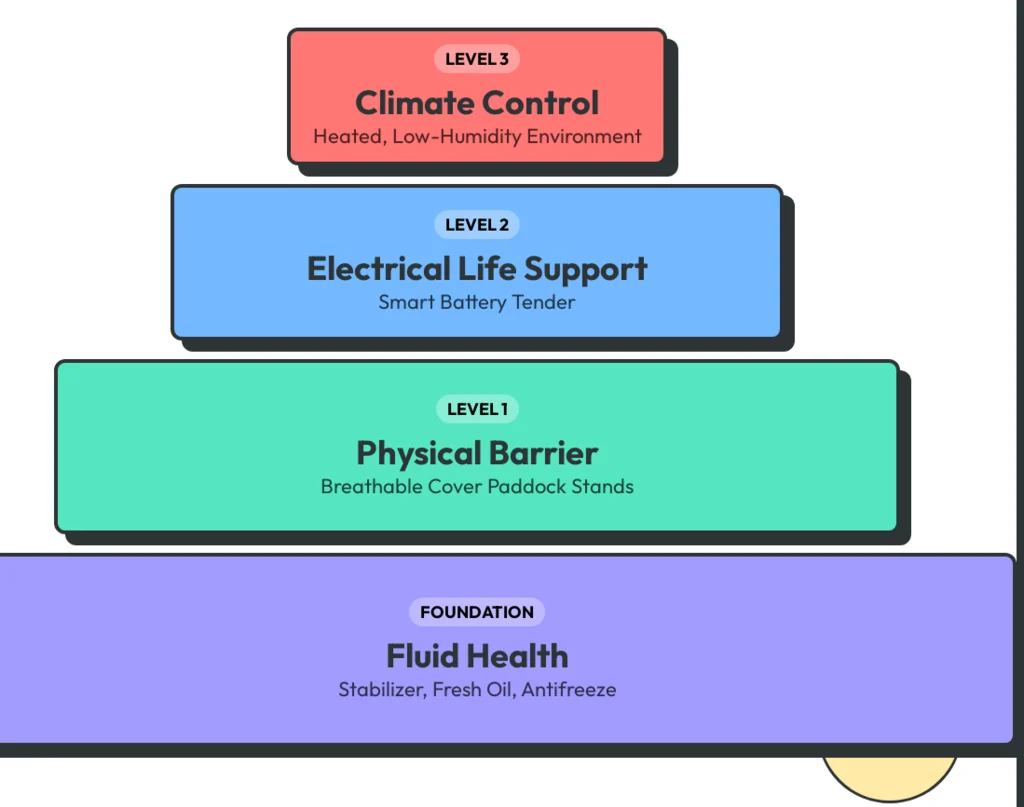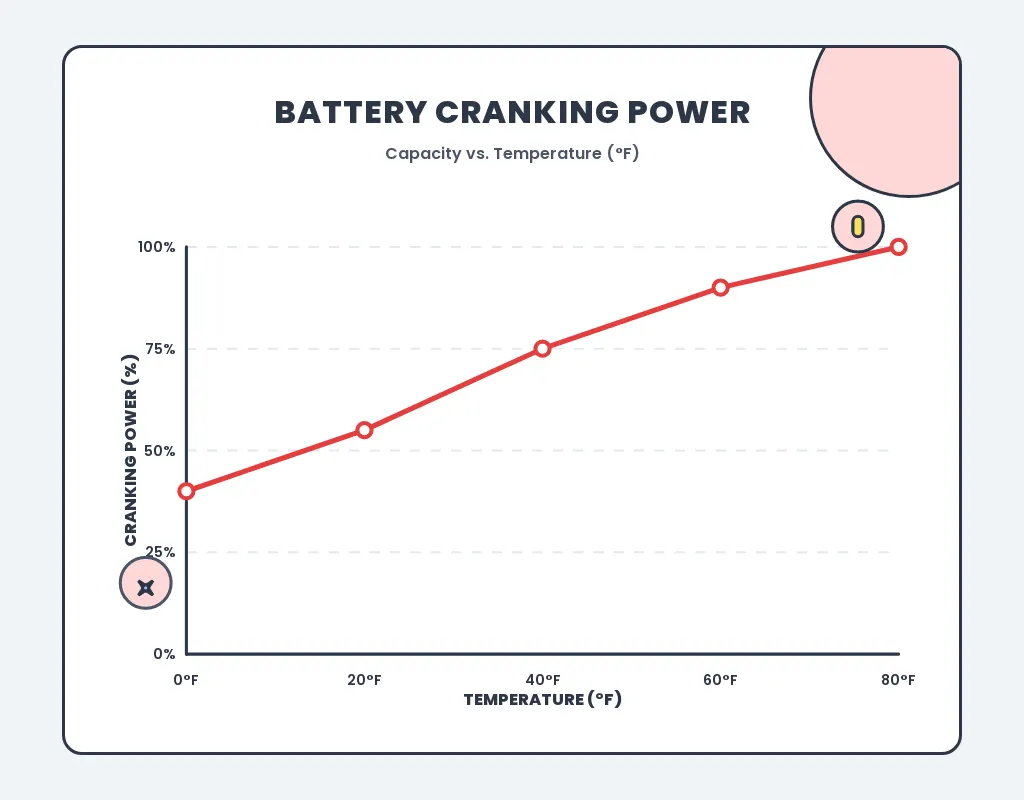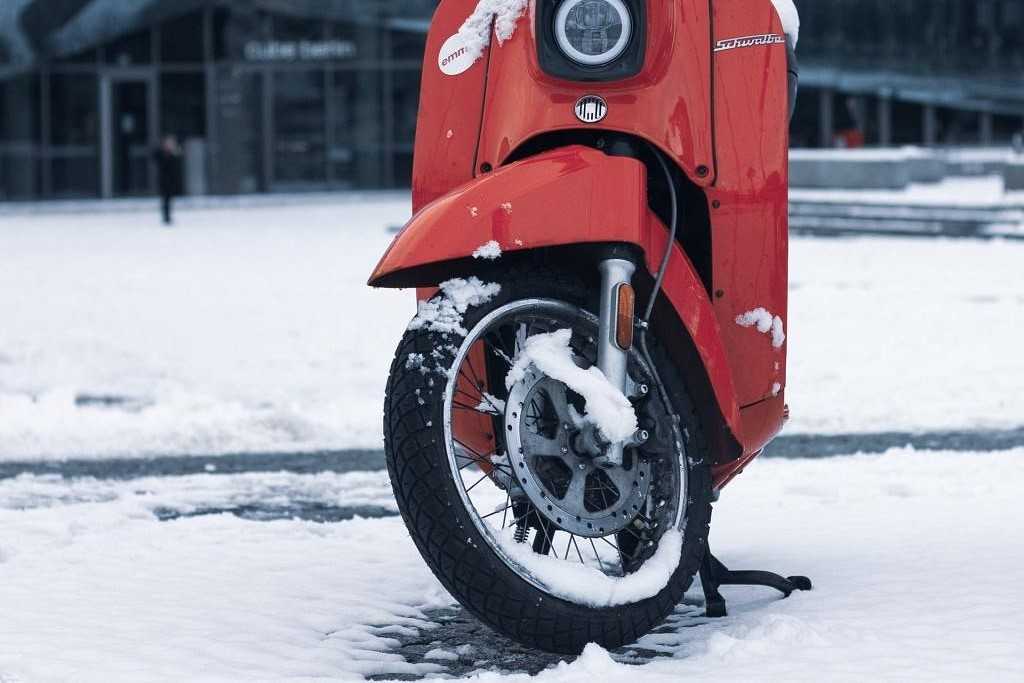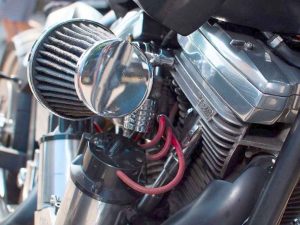Proper storage and preventive maintenance protect motorcycles in winter from corrosion, battery failure, and mechanical damage that cold weather causes.
Cold temperatures break down rubber seals, accelerate metal corrosion, and drain batteries. Your motorcycle faces harsh winter conditions whether you ride or store it. Without proper protection, you’ll find cracked hoses, seized engine components, and rust damage when spring arrives.
This guide covers essential winterization steps to keep your bike ready for riding season.
🎯 Key Takeaways
- Stabilize: Always add fuel stabilizer and fill the tank to prevent internal tank rust and clogged injectors.
- Battery Math: Batteries lose $35% of their power at $32°F. Use a smart tender to avoid a dead cell by spring.
- The Flat-Spot Fix: Keep tires off the ground using stands, or over-inflate slightly and rotate them monthly to prevent permanent rubber deformation.
- Clean Before You Lean: Road salt is “bike cancer.” Never store a dirty bike; salt + moisture = rapid corrosion.
- Warm-up the Oil: If riding, let the oil circulate for $2$-$3$ minutes. Cold oil is thick and won’t protect high-friction engine parts immediately.
Why Winter Damages Motorcycles
Freezing temperatures cause fluids to thicken, seals to crack, and moisture to accumulate inside the engine. Metal contracts in cold weather, creating gaps where water seeps in and causes rust on the chassis, exhaust system, and brake components.
Battery power drops 35% at 32°F compared to 80°F, according to Battery University. Condensation forms inside fuel tanks and carburetors when temperatures fluctuate, leading to fuel system corrosion and clogged jets.
Essential Winter Protection Methods

01. Store in a Climate-Controlled Space
Indoor storage between 50-55°F prevents temperature fluctuations that create condensation. A heated garage with low humidity stops rust formation on metal components and keeps rubber seals flexible.
If indoor storage isn’t available, find a covered area that blocks snow, rain, and direct wind exposure. Avoid damp basements where moisture accelerates corrosion on the frame and engine cases.
02. Use a Quality Motorcycle Cover
A waterproof, breathable cover blocks moisture while allowing condensation to escape. Look for UV-resistant fabric that prevents paint fading and plastic deterioration during storage months.
Dowco Guardian 50005-02 WeatherAll Plus Indoor/Outdoor Waterproof Motorcycle Cover
- Heavy-duty ClimaShield Plus fabric with sealed seams
- Heat shields protect against exhaust melting
- UV and fade resistant with compression storage bag
- Check current price
Secure the cover tightly so wind doesn’t lift it, but ensure vents remain clear to prevent trapped moisture underneath.
03. Maintain Proper Tire Pressure
Check tire pressure weekly during winter storage. Cold temperatures cause air molecules to contract, dropping pressure by 1-2 PSI for every 10°F decrease.
Maintain pressure at manufacturer specifications (typically 28-40 PSI). Underinflated tires develop flat spots where they contact the ground, creating permanent deformation that causes vibration when riding.
Use a rear paddock stand or center stand to lift tires off the ground completely. This eliminates flat spotting and reduces stress on suspension components during extended storage.
04. Protect the Engine and Fuel System
Change engine oil before winter storage. Used oil contains combustion byproducts and moisture that cause internal corrosion when the bike sits idle. Fresh oil provides a protective barrier on cylinder walls, valve trains, and bearings.
Fill the fuel tank completely and add fuel stabilizer to prevent gasoline degradation. A full tank eliminates air space where condensation forms. Run the engine for 5 minutes after adding stabilizer to circulate it through fuel lines and carburetors.
For motorcycles with carburetors, drain float bowls to prevent varnish buildup from evaporating fuel. Fuel injection systems don’t require draining.
Preparing Your Motorcycle for Storage
Complete Cleaning Process
Wash your motorcycle thoroughly using motorcycle-specific cleaner. Road salt, brake dust, and grime trap moisture against metal surfaces, causing pitting and rust during storage months.
Apply liquid degreaser to the chain, sprockets, and engine cases. Remove all salt residue from the frame, swingarm, and suspension components. Dry completely with compressed air or microfiber towels, paying attention to crevices where water collects.
Check and Top off Fluids
Inspect coolant level and concentration. Antifreeze should protect to -34°F minimum. Old coolant loses corrosion inhibitors that protect aluminum engine components.
Check brake fluid level and condition. Dark or cloudy brake fluid contains moisture that can freeze in brake lines and damage internal seals. Replace brake fluid if it’s more than two years old.
Battery Maintenance
Remove the battery and store it on a wooden shelf or battery mat, not directly on concrete, which can drain charge through the case. Connect a smart battery tender that maintains charge without overcharging.
Clean battery terminals with a wire brush and apply dielectric grease to prevent corrosion. A fully charged battery resists freezing better than a discharged one. At full charge, battery electrolyte freezes at -80°F; at 50% charge, it freezes at 10°F.

Apply Protective Coatings
Spray exposed metal parts with corrosion inhibitor or WD-40. Focus on chrome surfaces, brake rotors (wipe off before riding), and unpainted metal on the frame.
Apply a thin coat of wax to painted surfaces for additional UV and moisture protection. Wax creates a barrier that prevents oxidation and keeps paint looking fresh.
Long-Term Storage Beyond Winter
For storage exceeding 6 months, take additional steps to preserve mechanical components.
Lubricate Moving Parts
Apply grease to cables, levers, and pivot points. Spray chain lubricant generously on the drive chain to prevent surface rust. Move the bike slightly every few weeks to redistribute lubricant on seals and bearings.
Store the motorcycle vertically using a wall-mounted stand if possible. This position keeps fork seals lubricated and prevents oil from settling. If vertical storage isn’t feasible, use a rear paddock stand to reduce pressure on tires and suspension.
Start the Engine Monthly
Run the engine for 10-15 minutes once per month if storing for extended periods. This circulates oil through bearings, keeps cylinder walls lubricated, and prevents condensation buildup in the exhaust system.
Let the engine reach operating temperature to evaporate moisture from the crankcase. Don’t rev the engine, just let it idle. Shut off fuel if using a petcock to run carburetors dry before storing again.
Monitor Storage Conditions
Place a hygrometer near your stored motorcycle to track humidity levels. Keep relative humidity below 50% to prevent corrosion. Use a dehumidifier in closed storage spaces or moisture-absorbing products like DampRid.
Check your motorcycle every 2-3 weeks during storage. Look for rodent nests, fluid leaks, or signs of moisture accumulation. Block exhaust pipes and air intakes with steel wool to prevent pest entry, remove before starting the engine.
Protecting Motorcycles During Winter Riding
If you ride during winter months, different protection strategies apply.
Motorcycle Storage vs. Winter Riding
| Feature | Winter Storage Strategy | Winter Riding Strategy |
| Fuel System | Full tank + Stabilizer | High-quality fresh fuel |
| Cleaning | Deep clean + Wax/Sealant | Post-ride salt rinse (Every time) |
| Tires | Lifted off ground (Stands) | Daily pressure checks |
| Battery | Constant Smart Tender | Frequent long rides or tender |
| Protection | Breathable Indoor Cover | Corrosion inhibitor spray (ACF-50) |
Install Winter-Specific Accessories
Heated grips and handguards block wind and maintain hand dexterity in cold weather. Hand protection prevents fatigue that compromises control and reaction time.
Add engine guards and frame sliders to protect expensive components during low-traction drops. Winter roads with sand, salt, and ice increase fall risk even for experienced riders.
Post-Ride Cleaning Routine
Wash your motorcycle after every ride in snowy or salted conditions. Road salt causes rapid corrosion on aluminum and steel components. Spray undercarriage, swingarm, and suspension with fresh water to remove salt residue.
Dry the bike completely and apply chain lubricant after each wash. Lubricate cables and pivot points more frequently during winter riding—moisture accelerates wear on moving parts.
Cold Weather Starting Procedure
Let fuel-injected motorcycles warm up for 2-3 minutes before riding. Carbureted bikes need 5 minutes to allow choke to enrich the mixture properly. Cold oil flows slowly, leaving upper engine components unlubricated during initial startup.
Check tire pressure before every ride. Cold overnight temperatures can drop pressure below safe levels, affecting handling and traction.
Spring Motorcycle Preparation
When winter storage ends, prepare your motorcycle properly before the first ride.
Remove the cover and inspect for fluid leaks, rust spots, or rodent damage. Check tire pressure and inflate to specification, tires lose pressure during storage.
Charge the battery fully before installation. Clean terminals and check voltage with a multimeter (12.6V minimum for full charge). Replace batteries older than 4 years.
Change engine oil if you didn’t before storage or if the bike sat longer than 6 months. Check coolant level and inspect hoses for cracks. Replace rubber fuel lines if they feel hard or show surface cracks.
Start the engine and let it warm up completely. Check for unusual noises, vibrations, or warning lights. Test brakes in your driveway before riding, moisture can cause temporary brake fade that clears after a few applications.
Take a short test ride in a safe area to verify all systems function properly before returning to regular riding.
FAQs about Protect Motorcycles in Winter
Why should I store my motorcycle indoors during winter?
Indoor storage prevents rust from moisture exposure, protects paint and plastic from UV damage, and maintains stable temperatures that prevent seal deterioration. Even short outdoor exposure allows water infiltration that causes internal corrosion and mechanical problems.
How long can I safely store a motorcycle?
Motorcycles can remain stored for 6-12 months with proper preparation including fuel stabilizer, battery maintenance, and monthly engine starts. Beyond one year, seals may dry out, fluids degrade, and tires develop flat spots requiring replacement.
Should I drain the fuel tank for winter storage?
No, keep the tank full with fuel stabilizer added. An empty tank allows moisture condensation on internal surfaces, causing rust. Stabilizer prevents fuel degradation and maintains proper octane levels for up to 12 months of storage.
What’s the ideal temperature for motorcycle storage?
Store motorcycles between 50-55°F in low humidity conditions. This temperature range prevents condensation, keeps lubricants fluid, and maintains battery charge capacity. Avoid temperature fluctuations that create moisture inside the engine and fuel system.
Do I need a motorcycle cover indoors?
Yes, even indoor storage benefits from a breathable cover that blocks dust accumulation and protects against accidental scratches. Choose a cover that allows moisture escape while preventing dirt from settling on painted surfaces and mechanical components.
How do I prevent flat spots on motorcycle tires?
Lift tires completely off the ground using a rear paddock stand or center stand. If stands aren’t available, move the motorcycle slightly every 2-3 weeks to rotate tire contact points and reduce flat spot formation during extended storage.
Can cold weather damage my motorcycle battery?
Yes, cold temperatures reduce battery capacity by 35% at freezing and increase self-discharge rates. Remove the battery, store it at room temperature on a smart charger, and maintain full charge to prevent freezing damage and sulfation.
What should I do if I must store my motorcycle outside?
Use a high-quality waterproof cover with proper ventilation. Park on level ground with a tarp underneath to block ground moisture. Check weekly for water accumulation, remove the battery for indoor storage, and apply extra corrosion protection to exposed metal.
How often should I start my motorcycle during storage?
Start the engine monthly and let it run for 10-15 minutes until it reaches operating temperature. This maintains lubrication on internal components, prevents seal drying, and evaporates condensation from the exhaust system and engine cases.
Is professional storage worth the cost for motorcycles?
Climate-controlled storage facilities ($45-70 monthly) provide optimal protection when you lack garage space. Professional storage maintains consistent temperature and humidity, includes security monitoring, and prevents weather damage that could cost thousands in repairs or diminished resale value.




